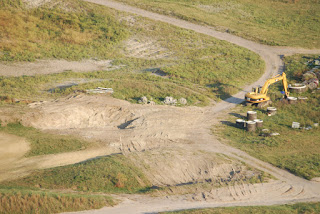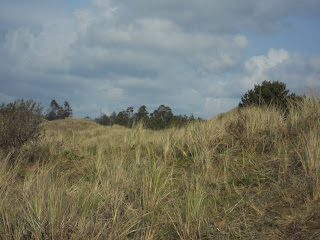
There is a special "old-timey" feeling that you get while driving up to the Biltmore hotel. The Biltmore boasts not only a 1925 Donald Ross golf course but also a 15 story tower, standing sentinal over the layout. Against the mostly flat property the tower appears even bigger, adding to the ambiance and charm of this golden age golf course.
When I first played the Biltmore about 10 years ago the 5th hole was a medium length par 4. However, much to my surprise and delight, the routing was somewhat different this time around. Ross's routing allowed for several different sequences and was easily altered. In its current sequence the rhythm and flow of the round is vastly improved. Golf architect
Mike Devries writes an excellent article on the subject, using Dr. Alistair Mackenzie's work at the Meadow Club as an example. Playing the Biltmore on this day was like discovering a brand new golf course all over again.
The
new 5th hole, formerly the 18th, is a 90-degree dogleg right with a deceptive array of bunkers guarding the fairway. The tee shot asks the golfer to make a somewhat uneasy risk/reward decision at just the right time in the round. Flashed up bunker faces also make it difficult to judge the distances between the bunkers guarding the inside and outside corner of the dogleg. One must decide whether to drive over the bunkers and cut the hole in half or to drive safely up an unobstructed fairway. As a finishing hole the options presented are compelling in a tight match, however the ensuing trade off in the routing is far superior.
Old Routing
 New Routing
New Routing
 Red
Red =
Front NineGreen =
Back Nine
By trading the
old 18th for the
new 5th, the golf course saves two of its best holes for the finish.
For me this trade-off makes the biggest difference in the flow of the round. The
old routing orders holes
6- 9 around a baranca which requires difficult shot making. In the
new routing, holes
7,
8, and
9 remain in order but the difficult
6th (now
17) is saved for the climax of the round.
Both holes (
17 &
7) present considerable risk/reward decisions over the baranca. However when put back to back these holes put too much pressure on the golfer. In regard to the flow of the round it is much preferred that they are separated in the order of play and it also gives an observant golfer a close up look to the
17th green from the
7th tee.
Risk/Reward # 7 Tee Shot

The
new 18th is a reachable par 5 which can make for an exciting finish. It is a strong hole guarded by bunkers all up the left side finishing with a large but flat green. After playing the new routing I was instantly struck by a very simple point made by Mr. Devries in his article, that a golf course is made up of a collection of holes to make a whole! Although the new finishing hole is not as extreme or flashy as the risk/reward
5th, the golfer is instead rewarded with a complete golf course emphasized by a sound routing and an appropriate build up of required shot making.
The
new par-5 15th is a true three shot hole with an excellent green site located above a lurking baranca. One should take plenty of club on the third shot to avoid getting too close to the steep


slope of the awaiting canal. The putting surface is shaped like a saddle, high on the left and right, sloping heavily from back to front, as are many of the greens at the Biltmore.
The
old 5th has now becomes the
new 16th, a gentle par 4. The golfer should look to score on 16 as the
new 17th presents the most difficult approach to a green on the entire golf course. From the tee the golfer can see the wooden bulkheads that separate the green from the winding baranca.

The 17th is a long par 4 that requires a strong drive over a cluster of trees on the right side of the fairway to gain the best approach to this well protected green. A poorly executed drive demands a smart lay up on the second shot or risk a 200 yard+ carry over water to an elevated green. Once you get to the green a two putt is not guaranteed on this heaving green, featuring several tiers and lots of slope coming at you from back to front.
In this opinion I have only tackled the meaty parts of the golf course who owe their character to the baranca that winds its way through 6 holes. The rest of the course is also pretty darn good, featuring deceptive fore-bunkers purposfully set in the line of play.

Depending on which tee you play the golf course could be extremely playable or difficult. There are two sets of back tees which seemed to be added at some point after the original construciton of the golf course, probably to accomodate the growing distance of the golf ball. Many of the standard white tees (~6,000 yards) are very close to the previous green, which I enjoyed as a walking golfer, but I found this a bit too short as I hit mostly wedges and lower irons into the par 4's.
The Biltmore is one of my favorite places to play golf in South Florida and will continue to provide enjoyable golf for many more golfers who may see other versions of its creative and adaptive routing.



































